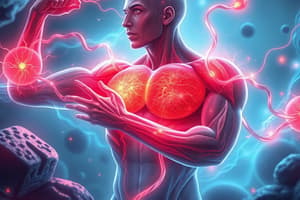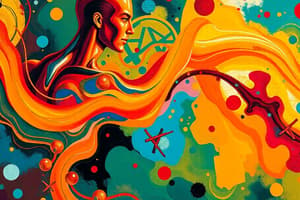Podcast
Questions and Answers
What is the main energy system used during maximum intensity activities lasting no longer than 10 seconds?
What is the main energy system used during maximum intensity activities lasting no longer than 10 seconds?
- Anaerobic glycolysis
- Lactic acid system
- Aerobic system
- ATP/PC system (correct)
Which process helps in removing blood lactate during anaerobic activities?
Which process helps in removing blood lactate during anaerobic activities?
- Cori cycle (correct)
- Glycogenolysis
- Oxidative phosphorylation
- Beta oxidation
What type of physical activities predominantly rely on the aerobic energy system?
What type of physical activities predominantly rely on the aerobic energy system?
- 400m sprints
- Weightlifting
- Long-distance running (correct)
- 100m sprints
Which of the following statements about the anaerobic glycolysis system is true?
Which of the following statements about the anaerobic glycolysis system is true?
What is formed when AMP is deaminated by AMP deaminase?
What is formed when AMP is deaminated by AMP deaminase?
What is the primary function of muscle tissue?
What is the primary function of muscle tissue?
Which type of muscle is under voluntary control?
Which type of muscle is under voluntary control?
Which type of muscle fiber is characterized by a high capacity for ATP production via oxidative phosphorylation?
Which type of muscle fiber is characterized by a high capacity for ATP production via oxidative phosphorylation?
Which of the following describes slow twitch (Type I) muscle fibers?
Which of the following describes slow twitch (Type I) muscle fibers?
What structure surrounds the sarcoplasm of a muscle cell?
What structure surrounds the sarcoplasm of a muscle cell?
Which of the following characteristics is true about fast twitch type IIb muscle fibers?
Which of the following characteristics is true about fast twitch type IIb muscle fibers?
What role does creatine phosphate play in muscle cells?
What role does creatine phosphate play in muscle cells?
Which type of muscle tissue is primarily responsible for involuntary movements?
Which type of muscle tissue is primarily responsible for involuntary movements?
What is the main source of energy production during high-intensity activity?
What is the main source of energy production during high-intensity activity?
Which amino acids are involved in the synthesis of creatine?
Which amino acids are involved in the synthesis of creatine?
What role does creatine kinase (CK) play in energy metabolism?
What role does creatine kinase (CK) play in energy metabolism?
What happens to creatinine once it is formed in the body?
What happens to creatinine once it is formed in the body?
Which CK isoenzyme is primarily found in the brain?
Which CK isoenzyme is primarily found in the brain?
How does the amount of creatinine excreted in urine relate to muscle mass?
How does the amount of creatinine excreted in urine relate to muscle mass?
What substances react to form creatine phosphate?
What substances react to form creatine phosphate?
During exercise, ATP is broken down into which metabolites?
During exercise, ATP is broken down into which metabolites?
Flashcards
Muscle Energy Supply
Muscle Energy Supply
Muscles require a constant supply of chemical energy (ATP and creatine phosphate) to function.
Skeletal Muscle Fibers
Skeletal Muscle Fibers
Long, cylindrical cells that make up skeletal muscles, attached to bones, and responsible for movement.
Slow-Twitch Muscle Fibers (Type I)
Slow-Twitch Muscle Fibers (Type I)
Muscle fibers rich in mitochondria and myoglobin, that contract slowly, are resistant to fatigue, and are used for sustained, low-intensity activities.
Fast-Twitch Muscle Fibers (Type II)
Fast-Twitch Muscle Fibers (Type II)
Signup and view all the flashcards
Type IIa Muscle Fibers
Type IIa Muscle Fibers
Signup and view all the flashcards
Type IIb Muscle Fibers
Type IIb Muscle Fibers
Signup and view all the flashcards
Muscle Structure
Muscle Structure
Signup and view all the flashcards
Muscle Control
Muscle Control
Signup and view all the flashcards
ATP/PC system
ATP/PC system
Signup and view all the flashcards
Anaerobic Glycolysis
Anaerobic Glycolysis
Signup and view all the flashcards
Aerobic system
Aerobic system
Signup and view all the flashcards
AMP deamination
AMP deamination
Signup and view all the flashcards
Energy Systems
Energy Systems
Signup and view all the flashcards
Creatine
Creatine
Signup and view all the flashcards
Creatine Phosphate
Creatine Phosphate
Signup and view all the flashcards
Creatine Kinase (CK)
Creatine Kinase (CK)
Signup and view all the flashcards
Creatinine
Creatinine
Signup and view all the flashcards
ATP
ATP
Signup and view all the flashcards
Adenylate Kinase
Adenylate Kinase
Signup and view all the flashcards
Creatine Synthesis
Creatine Synthesis
Signup and view all the flashcards
Study Notes
Creatine Metabolism, High Energy Phosphates, and Muscle Energy Supply
- Creatine metabolism, high energy phosphates, and muscle's energy supply are interconnected.
- Muscle is the primary biochemical transducer that converts chemical energy into mechanical energy.
- Muscles maintain a constant supply of chemical energy, primarily ATP and creatine phosphate.
- Neural control of muscles regulates speed, force of contraction, duration of activity, and return to original state.
Muscle Types
- Muscles are categorized into smooth, skeletal, and cardiac.
- Skeletal muscles (attached to bone for movement) are striated.
- Cardiac muscles are striated, responsible for heart function.
- Smooth muscles (lining digestive tract and blood vessels) are non-striated.
- Skeletal muscles are under voluntary nervous control; smooth and cardiac muscles are involuntary.
Skeletal Muscle Structure
- Skeletal muscle fibers run the length of muscles and are multinucleated.
- These fibers contain numerous mitochondria for ATP production, crucial for muscle contraction and relaxation.
- Muscle fibers consist of myofibrils arranged in parallel (sarcomeres).
- Myofibrils are embedded in sarcoplasm (cytoplasm of fiber) and surrounded by sarcolemma (excitable plasma membrane).
- Sarcoplasm contains glycogen, glycogenolysis enzymes, glycolytic enzymes, ATP, and creatine phosphate.
Skeletal Muscle Classification
- Muscle fibers are classified as slow-twitch (Type I) or fast-twitch (Type II).
- Slow-twitch fibers are rich in mitochondria and myoglobin (red color) and are highly oxidative (aerobic).
- They contract slowly, sustain contractions, and resist fatigue, suitable for repeated low-intensity activities (jogging, walking).
- Fast-twitch fibers (Type II) are further subdivided into Type IIa and Type IIb.
- Type IIa fibers are intermediate, and faster contracting, and have high myoglobin content (red).
- Type IIb fibers have few mitochondria and low myoglobin (white), rely primarily on anaerobic glycolysis (fast, but unsustainable), and fatigue quicker.
- Fast-twitch fibers are used for short bursts of high-intensity activities (sprints, heavy weightlifting).
Creatine Synthesis
- Creatine is not an essential nutrient, naturally produced in the human body from amino acids (glycine and arginine) or found in meat in the diet.
- Creatine synthesis begins in the kidneys and is completed in the liver.
- Glycine combines with arginine in the kidneys to form guanidinoacetate, which then travels to the liver.
- In the liver, guanidinoacetate is methylated by S-adenosyl methionine to create creatine.
- Creatine then travels in the bloodstream to tissues (brain, heart, skeletal muscle).
- Creatine reacts with ATP to form creatine phosphate.
- The reaction is catalyzed by creatine phosphokinase (CK) and is reversible, enabling cells to use creatine phosphate to regenerate ATP.
- The amount of phosphocreatine is proportional to muscle mass.
Creatine Kinase (CK)
- CK is necessary for converting creatine to phosphocreatine.
- Different CK isoenzymes (CK-MM, CK-MB, CK-BB) are located in various tissues.
- CK levels are clinically important; increased levels indicate damage or injury in skeletal muscle or heart tissue (e.g., crush injuries, myocardial infarction).
Creatinine Metabolism
- Creatine phosphate is unstable, spontaneously converting to creatinine.
- Creatinine cannot be further metabolized and is excreted in urine.
- Daily creatinine excretion is constant, directly related to muscle mass.
- Decreased muscle mass (e.g., muscular dystrophy, paralysis) leads to lower creatinine excretion.
- Kidneys play a key role in creatinine metabolism. Damaged kidneys cause creatinine to build up in the blood. (Serum creatinine is used to assess kidney health).
ATP Metabolites
- During exercise, ATP is broken down to ADP.
- Some ADP is reconverted to ATP through adenylate kinase reaction forming ATP and AMP (AMP is an auxiliary source of energy).
- AMP is further broken down to IMP and ammonia.
- AMP can also be dephosphorylated into adenosine, which acts as vasodilator increasing blood supply to the muscle.
Energy Systems
- The body uses various energy systems (ATP-PC, anaerobic glycolysis, aerobic) depending on the activity's intensity and duration.
- ATP-PC is predominant during short-duration, high-intensity exercises (e.g., sprints).
- Anaerobic glycolysis (lactic acid system) is the primary supplier of energy for short-term, high-intensity activities (e.g., 400 m sprint).
- Aerobic energy system provides energy for longer-duration, low-to-moderate intensity activities (e.g., endurance activities).
Studying That Suits You
Use AI to generate personalized quizzes and flashcards to suit your learning preferences.




